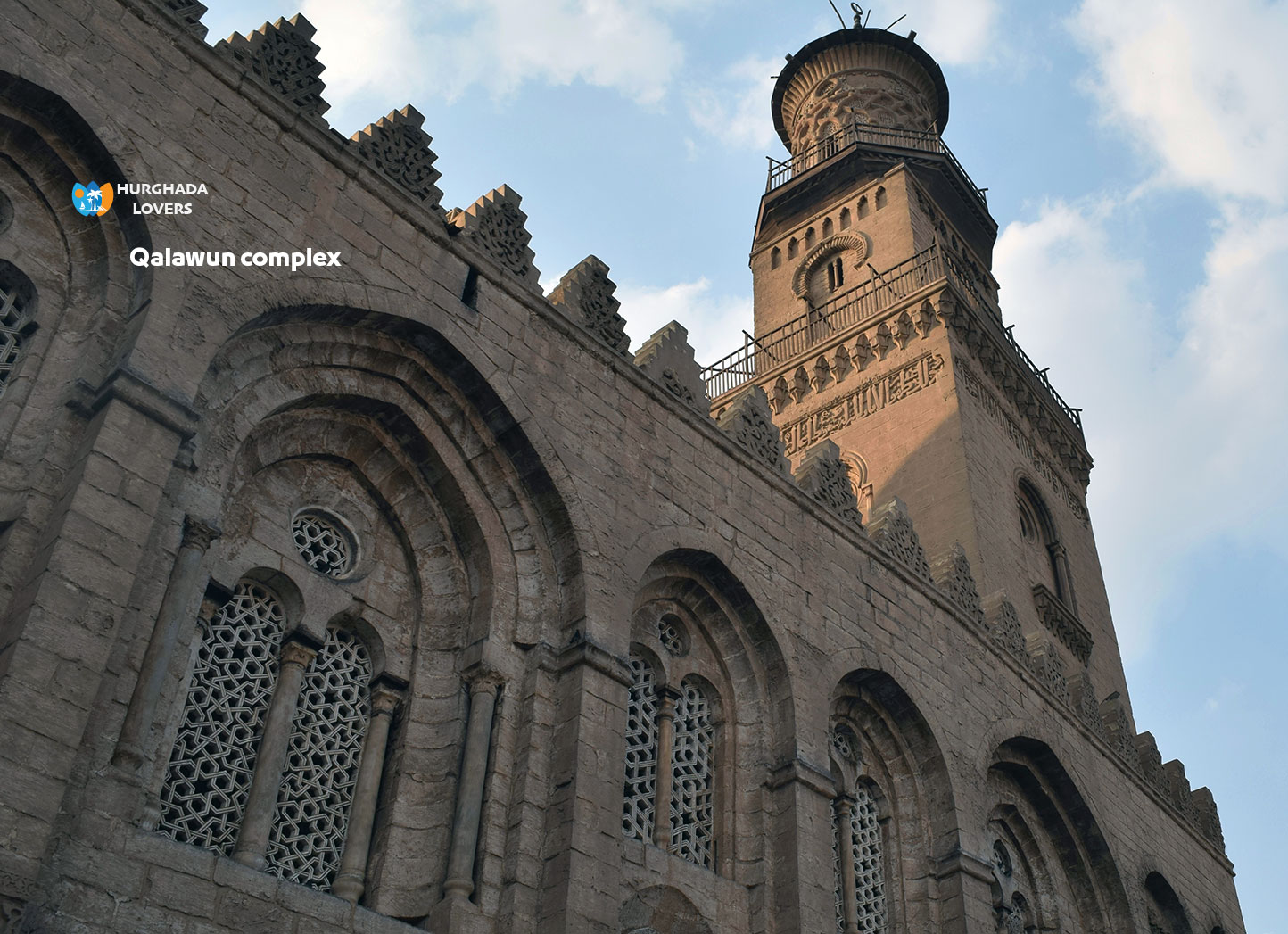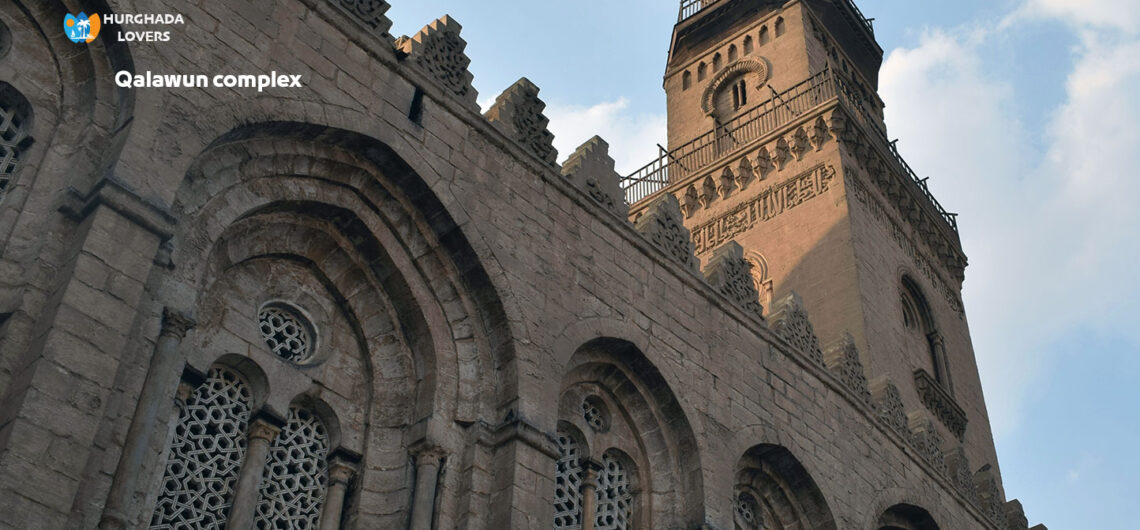Qalawun complex in Al Muizz street in Cairo, Egypt | Facts, History, Map, Design of Sultan Al-Nasser Mohammed Ibn Kalawoun Mosque and more about Madrasa, Mausaleum, and a hospital (bimaristan) …
Discover the facts and history of building a mosque, school, dome, mausoleum, and Bimaristan al-Mansur Qalawun from the Mamluk era to rule Egypt and more.
Or the mosque, school and dome of Bimaristan al-Mansur Qalawun in al-Muizz Street, Cairo, Egypt. The history of building the mausoleum, the minaret, the school, and the historical aspect of the most important Islamic monuments in Egypt.
Sultan Al-Mansur Saif al-Din Qalawun built a group of buildings in the year 684 AH, corresponding to 1285 AD, in the Mamluk Circassian style, which includes a mosque and a school in addition to a mausoleum and a bimaristan.
Hurghada lovers Offer Luxury Hurghada to Pyramids Tours | El Gouna to Pyramids Tours | Makadi bay to Pyramids Tours | Sahl Hasheesh to Pyramids Tours | Soma bay to Pyramids Tours .
Qalawun complex
You will find Sultan Qalawun’s group directly overlooking Al-Muizz Street, with a distinctive memorial entrance and façade, while you will find the Bimaristan inside the group, as it was used to treat patients from the Egyptian people and the Mamluks.
You will see the façade of the mausoleum of Sultan Qalawun divided into recesses knotted from the bottom of the windows with grilles surmounted by umbrellas, in addition to a tape written in the third line of the founding and date of the establishment of the mosque and the name of Sultan Qalawun.
The façade of the school is distinguished as it is divided into 5 cavities with knotted windows at the bottom with grilles, then a sunshade, then a lamp. You will also see the founding text on the façade of the mausoleum, in addition to balconies decorated with stucco Islamic motifs in the molded style.
The group includes a sabil on the facade of the school in the veil style, as it had a dome resting on a neck in the form of an octagon with columns of tiles made of faience.
At the top of the entrance opening, you will see a lintel on which the founding text is written, in addition to the order. There is between the school and the shrine (a square shape with an area of 21 by 22 meters, with 4 columns in the middle with 4 buttresses), where the entrance leads to a vestibule (4 meters wide, 35 meters long, and 10 meters high).
The vestibule was designed with a ceiling of wooden barrels and panels decorated with a star shape, in addition to the presence of 6 doors in the chest, two of which lead to the place of the Bimaristan, two to the place of the shrine, and two directly to the school.
On the walls of the mausoleum, you will see the domes of Sultan al-Mansur Qalawun on wooden panels in the shape of an octagon, with distinctive colors, gold-plated, and Islamic decorations in the Mamluk style.
You will find the mihrab in the middle of the southeastern wall of the mosque, where it is a cavity with one knot of fake forged castanets and decorated with 3 mosaic horns and stripes of marble.
In the middle of the mausoleum, you will find a marble structure with a wooden sarcophagus written on it in kufic script and naskh, where Sultan al-Mansur Qalawun and his son al-Nasir Muhammad were buried in the mausoleum.
You will find a 3-storey minaret, where the first and second floors were designed in the form of a square, and the third floor in the form of a cylindrical oblique, then a non-polygonal top that was built during the reign of Sultan Al-Nasir Muhammad bin Qalawun.
You will find carved inscriptions and decorations on the entrance door made of wood, with interest in knowing the collection of Sultan Al-Mansur Qalawun.
Al-Nasir Muhammad Ibn Qalawun Mosque
The mosque was built in the year 735 AH. You will find it immediately after the middle door among the mosques of Salah al-Din Citadel, where King Al-Nasir Muhammad bin Qalawun, “the Mamluk state of the Bahriyya,” built the mosque, and his era witnessed the flourishing of the Mamluk eras of the rule of Egypt, where he took over the rule of Egypt in 693 AH He passed away in 741 AH.
King Al-Nasir Muhammad bin Qalawun loved the art of architecture, especially being influenced by Persian and Andalusian art, as he developed and restored many monuments and built mosques, schools and palaces during his rule of Egypt.
The mosque is characterized by a mihrab measured for the decades of its warriors and a marble cladding inlaid with mother-of-pearl, in addition to colored and gold-plated ceilings and bowls. In addition to a dome covered with green faience, it was called the green minaret or the green dome.
The Al-Nasir Muhammad Ibn Qalawun Mosque was designed in the form of 4 canopies around an open courtyard, in addition to upper windows that include a group of stucco windows with unique decorations and colors.
Sultan Qaytbay repaired the Al-Nasir Muhammad Ibn Qalawun Mosque, rebuilt its dome and built a marble pulpit in 893 AH after the mosque was vandalized and neglected after the death of King Al-Nasir Muhammad Ibn Qalawun.
The Egyptian government and the Antiquities Committee took care to repair the dome and the rest of its niche, in addition to restoring it again with the same quality, Islamic drawings and decorations that were present and more Qalawun complex.


